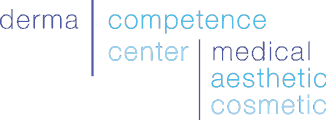Lasering – the only effective treatment to remove tattoos!
We gladly offer consultation
Introduction
Tattoos are described as pigment that is intentionally or unintentionally introduced into the skin. These cannot be broken down by the body and remain visible for life.
Today, lasering is the method of choice to remove unwanted tattoos. Depending on the ink color, dermatologist Dr. Hero Schnitzler in Zurich Enge chooses the suitable laser with the perfect wavelength to remove almost any tattoo.
Table of contents
1. What exactly are tattoos?
Tattoos are pigments injected into the skin. When injected into the middle layer of the skin, the dermis, and stored by the connective tissue cells, the fibroblasts, they become permanent. Tattoos cannot be broken down by the body. They stay visible for life, though over the years they may lose their intensity and become faded.
Though tattoos are mostly done as a permanent decoration on the body, personal preferences and attitudes towards one’s appearance often change over time. All too often, professional decisions also play a role in deciding to have tattoos removed. To have an unwanted tattoo lasered, a doctor with experience in tattoo removal should be consulted.
2. What kinds of tattoos are there?
Tattoos are ingrained in human society. Tattooing has been carried out for centuries. Most tattoos these days are “deco” tattoos. These are deliberately engraved, single or multi-colored images and inscriptions in the skin. Today, they are practically everywhere and well accepted by society. Along with the prevalence, the professionalism, variety of colors and implementation has developed significantly. In the past, the small typical blue-black tattoos were most common. Nowadays you can see more multicolored and large tattoos, some of which adorn entire areas of the body.
In the past, tattoos were usually associated with individual professions and groups. Sailors came back home from the distant world with this decorative souvenir.
But there are also religious, medicolegal and political indicative tattoos. These in particular often become undesirable and wearers ask for these tattoos to be lasered away.
Another type of tattoo is what is known as an accidental tattoo. In this case, pigment particles have unintentionally penetrated the skin which again, cannot be broken down by the body. These occur in part after insufficient cleaning of open wounds, particle blasting after explosions, but they can also result from leakage of an infusions, especially iron infusions.
3. What is the best way to remove a tattoo?
Until a few years ago, tattoo removal was done without a laser. Tattoos were scraped away using dermabrasion. The top layer of the skin was removed with a special device. The color-bearing skin layers were removed with severe pain. A large tattoo could not be easily removed with this technique. This type of tattoo removal creates scars and as with surgical or excision tattoo removal, cannot be done without scarring.
Attempts to remove tattoos with various home remedies (e.g., from the internet) fail. The use of liquid, pigment-dissolving substances and also tattoo removal creams offered on the internet are used in attempts to remove tattoos. Although this sounds harmless, it is usually associated with very serious risks for the skin and the entire organism. The aesthetic results are very bad.
In the meantime, lasering has established itself for tattoo removal.
For tattoo removal, a laser that works with very intense and extremely short pulses from a short distance is aimed directly at the areas of the skin that have been colored.
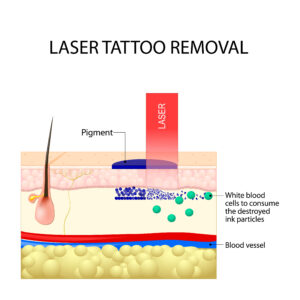
The device emits fine, barely visible flashes of light. These break up the color pigments into the smallest of fragments. The shattered pigment is then broken down and expelled by the body’s own immune cells. These are not harmful to health.
In the process of tattoo removal, the tattoo loses part of the color intensity after each lasering and afterwards becomes completely invisible.
.
4. What is the process of tattoo removal?
The process of tattoo removal requires several sessions. In this process, after the first one to two laser sessions, the tattoo will appear as before. After the 3rd session you can usually see a clear lightening. The aim is to laser the tattoo until it is invisible afterwards.
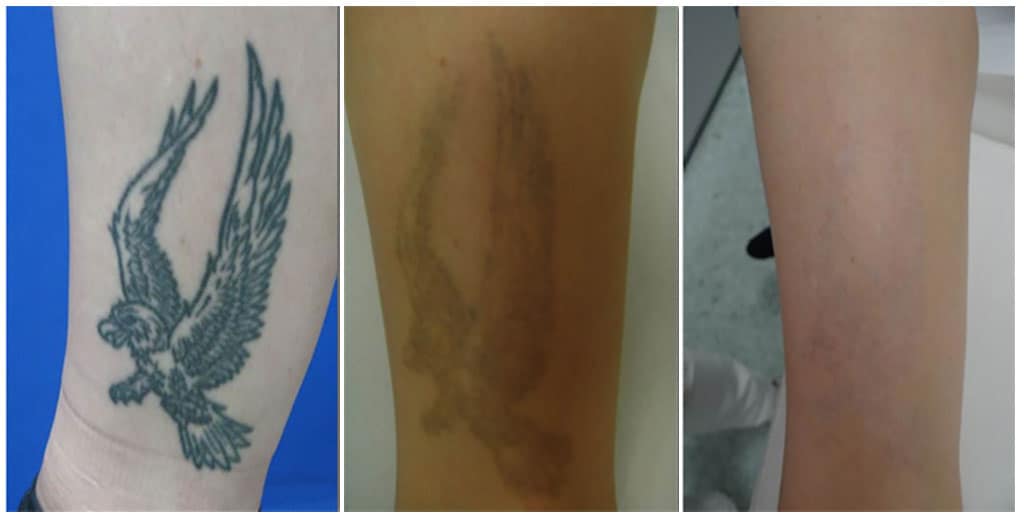
Process of tattoo removal: before, after 5 treatments, after 9 treatments
Tattoo removal is carried out by dermatologist Dr. Schnitzler in Zurich Enge with the aid of cold air anesthesia. A large tattoo must be made insensitive with anesthetic cream before the tattoo is removed. This way, the tattoo lasering is much less painful.
Afterwards, a soothing cream is applied to the treated skin areas. Showering is possible again on the next day.
5. What side effects are there with tattoo removal?
Such treatment is not entirely risk-free. In the course of a tattoo removal, severe side effects on the skin and very rarely severe, allergic reactions can occur. Tattoo removal should only be carried out by an experienced doctor like Dr. Schnitzler.
After the tattoo laser treatment, sometimes small blisters and scabs appear which loosen after 7-10 days.
In contrast to the dark tattoo beforehand, after lasering a whitish frost like relief can sometimes be seen for a certain period of time.
In addition, only a dermatologist with experience in tattoo removal can tell whether there are any malignant skin changes hidden by the ink colors.
6. Which laser is the right laser?
Depending on skin type, the colors contained in the tattoo, the age of the tattoo and any prior treatments, the correct wavelength of the laser to be used must be selected. The length of the laser pulse must also be individually determined.
At the derma competence center in Zurich Enge, all currently available and effective pulse durations and wavelengths are available in various lasers. The tattoo removal lasers offer different pulse lengths (nano- and picosecond lasers) for laser tattoo removal.
Differences in Tattoo Colors:
Black, blue-black, and red respond best to treatment. It becomes more difficult with tattoos in yellow, brown, and violet.
Dark blue-black tattoos respond very well to the Q-switched Neodymium YAG laser or the picosecond laser with a wavelength of 1064nm.
Red and orange tattoos should be treated with a wavelength of 532 nm using the Q-switched KTP laser or a picosecond laser with this wavelength.
Green, blue and also purple can usually be treated with the Q-switched Alexandrite laser or the picosecond laser. This works with a wavelength of 755nm.
For pre-treated tattoos and treatment-resistant tattoos, the Ruby laser is very effective, as it can penetrate deep into the skin due to its wavelength of 694 nm. However, treatment with a picosecond laser can also be a promising alternative.
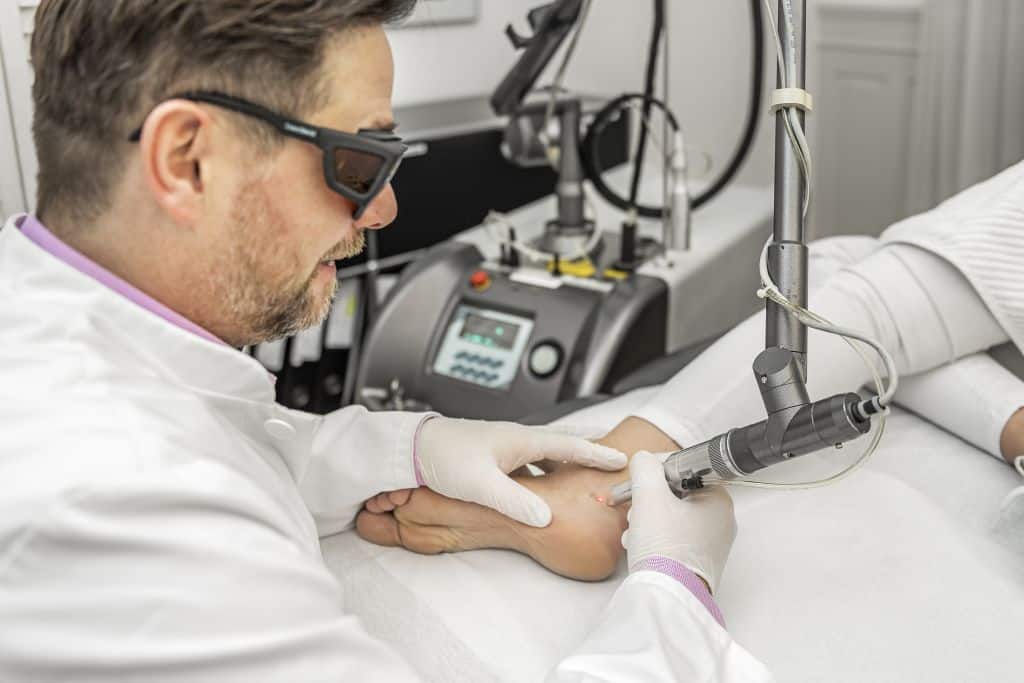
Tattoo removal with the Neodymium YAG laser
Dermatologist Dr. Schnitzler uses the Neodymium YAG laser to remove a colorful tattoo.

Tattoo removal in detail with the Neodymium YAG laser
Treatment process with the Neodymium YAG laser for tattoo removal by dermatologist Dr. Schnitzer, highly experienced in the area of laser removal of tattoos.
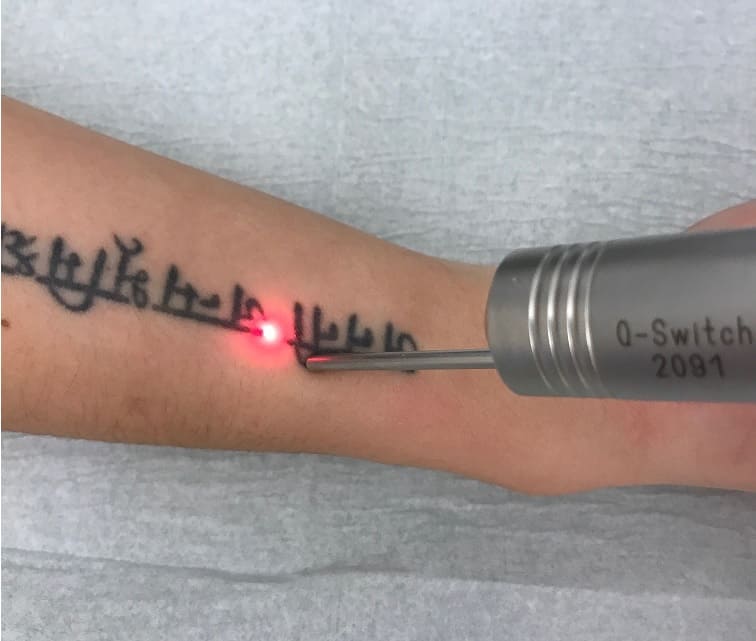
Tattoo removal in detail with the Ruby laser
Lasering of a tattoo in detail for tattoo removal without scarring
How does a pico laser work and how does it differ from a nano laser?
The main difference between nano lasers and pico lasers lies in the duration of their light pulses. Nano lasers operate in the nanosecond range (billionths of a second), while pico lasers operate in the picosecond range (trillionths of a second).
These different pulse durations lead to different mechanisms of action.
What effect does the pico laser have?
The mechanism of action of the pico lasers includes an additional photoacoustic effect, alongside the (photothermal) photomechanical effect. The pico laser generates shock waves that break down pigment particles into extremely small fragments, which the body can then eliminate more easily.
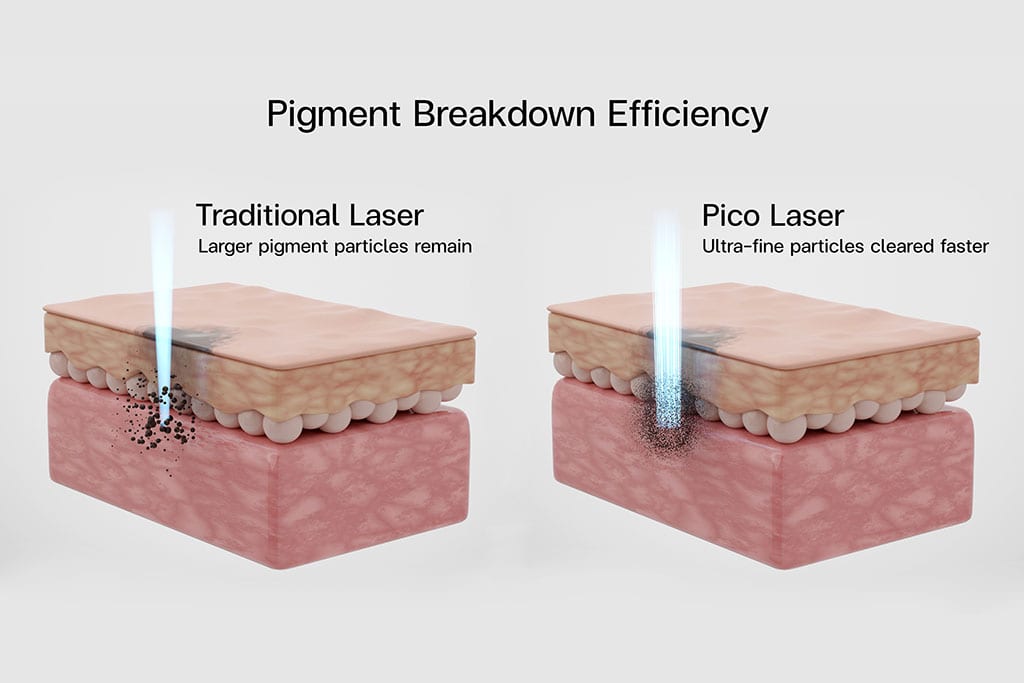
Pigment Breakdown Efficiency © wangmando / stock.adobe.com
What are the advantages of a pico laser?
The pico laser is sometimes perceived as less painful.
It is not certain whether fewer treatment sessions with a pico laser compared to a nano laser are required to completely remove a tattoo.
However, the pico laser can often fully remove residual pigments that no longer respond to treatment with nano lasers.
Which laser, or combination of different tattoo lasers, is the most gentle and effective option for a given tattoo and skin type must be determined individually by an experienced laser physician.
7. What does a tattoo removal cost?
The question of what a tattoo removal will cost cannot be answered across the board.
The cost of tattoo removal depends on the size of the tattoo and thus the number of laser pulses used.
It should be noted that each session should be billed separately because it is not possible to foresee how many sessions with what number of pulses will be required. The costs of tattoo removal incurred per session is discussed with the patient in the obligatory pre-consultation with the doctor experienced in tattoo removal, as with dermatologist Dr. Hero Schnitzler.
8. Summary of facts on tattoo removal
- the process of removing a tattoo always requires more than one session
- the location of the tattoo and so the skin’s thickness plays a role
- the color intensity, number of injections plays a role
- the laser must correspond to the color(s) of the tattoo
- the sessions are mildly painful, minor blistering can occur
- tattoo removal can vary greatly in costs
- even large tattoos can be removed, it’s just more complex

Autor - Dr. med. Hero P. D. Schnitzler
I am Dr. Hero P. D. Schnitzler and founded the derma competence center in Zurich Enge in 2015, which I have been managing with heart, soul and professional competence ever since.
I am a member of various Swiss and international professional societies and a long-time lecturer for aesthetic laser medicine (D.A.L.M.) at the University of Greifswald, and for the Swiss skills program FMCH laser treatments of the skin.
